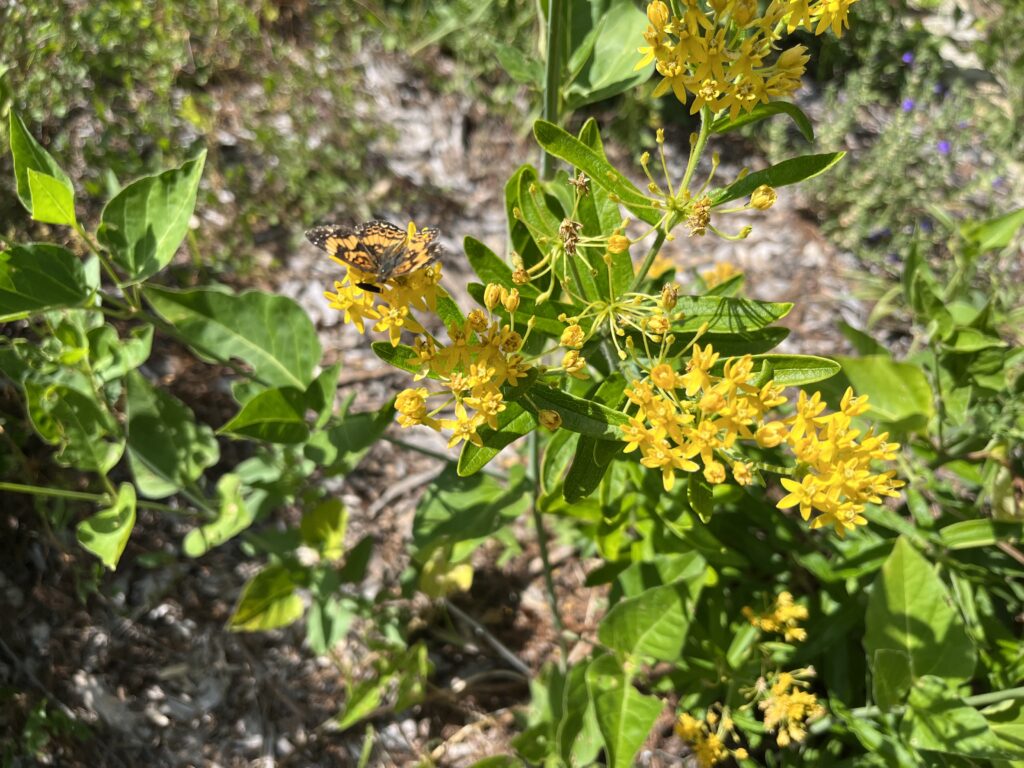We get a lot of questions about what exactly it means for a native plant to be a cultivar or a variety, and how that might affect pollinator attraction or ecological value. The short answer is: it’s complicated! To really understand the conversation happening around nativars, it is important to understand how they come to exist. How is that plant reproduced? Where it was discovered? What does the patent says about its parentage? It can be a tricky road full of complicated terminology, and we will be posting a series of blogs to dig into this topic, and how it applies to the native plants common in the Arboretum and at our FloraKansas fundraiser events.

The first post in this series is a primer on terminology used in these discussions. Future posts will cover naturally occurring varieties versus cultivars, hybridization and breeding programs, and what it all means for native plant enthusiasts!
The Language of Plants
Cultivar, hybrid, variety — these terms are often tossed around willy nilly and their definitions get mixed up. This article does a fantastic job of explaining it in lay terms, but the even shorter version is:
- Variety = naturally occurring genetic variation within a plant species. Seed is usually true to parent plant.
- Cultivar = variation within a plant species developed through human intervention; seed usually is not true to parent plant.
- Hybrid = product of a cross between two different species or varieties, which can occur naturally or by human intervention. Seed may be sterile, or may be viable, and may or may not grow to reflect the parent plants.
A naturally occurring variety may later be found to be the product of spontaneous hybridization. A hybrid plant may have been created with two cultivars as parent species. These descriptors are not always mutually exclusive, and can overlap in confusing ways!

These simple definitions from the American Begonia Society are also helpful:
A SPECIES is a natural grouping of similar plants that can interbreed and reproduce by seed.
A NATURAL HYBRID occurs between two different species.
A VARIETY appears naturally within a species, but it has some distinctive trait which sets it apart.
Just to Muddy the Waters…
‘Variety’ is different than ‘Plant Variety’. As frustratingly similar as those terms are, the first is a taxonimical distinction, while the second is a horticultural industry term. For example, Baptisia australis var. minor is a natural variation on Baptisia australis. It is shorter and more compact than the regular species. This is a botanical or taxononmical variety, and you can tell by the way it is written. But a Plant Variety is usually listed ‘like this’, and describes a patented cultivar. This distinction protects the plant breeders rights. Echinacea ‘Summersong FireFinch’ (listed as Echinacea purpurea G0052Y under its patent) is an example. Too often even the plant producers and sellers do not use the terms uniformly. I have seen Baptisia australis var. minor tagged as Baptisia ‘Minor’, which may cause people to think it is a patented or man-made variety, when it is not.
All that to say, it is very difficult to know what you are getting sometimes! Check out our other posts diving into detail on hybrids and cultivars to get a better understanding of what to look for when purchasing.

Other important terms you may want to be aware of for future posts:
Diploid and Tetraploid – the number of chromosomes in the plants cells. Diploid plants have two sets of chromosomes, tetraploid have four sets. Both occur in the natural world, and one is not necessarily better than the other, though tetraploid plants do show some benefit in yield, palatability, and vigor.
F1 hybrid plant or seed – product of the pollination of two different parent plants, short hand for Filial 1, or “first children”. This can happen naturally, as in the case of peppermint. But it is often it is performed by humans to create disease resistant and more desirable plants. It is responsible for huge advances in the food stability and supply of important crops. This kind of plant breeding was studied and recorded carefully by monk Gregor Mendel over 150 years ago!
Controlled Pollination – purposefully transferring pollen from one plant to the receptive female stigma of another plant, while removing the possibility for other pollen to fertilize that plant. At its simplest, controlled pollination is doable by the home gardener with the desired pollen dusted on a paintbrush, tweezers to remove the male anthers on the flower (if the flower is bisexual), a plastic bag to keep out any other wind-born pollen.
Subspecies – a taxonomic distinction just below species, meant to indicate a group within a species that is distinctly different but still close enough to be interbred with the species. Usually a subspecies is somewhat geographically isolated. Often confused with a variety, and sometimes a plant initially identified as a variety eventually becomes designated as subspecies.
Know Better, Do Better
A paraphrase from Maya Angelou, this saying is applicable in all parts of life, including gardening! Knowing the terminlogy of the trade ultimately helps us make better decisions in our gardens. Scientific lingo is cold and uninviting, but we shouldn’t just dismiss certain plants as “unnatural” just because the terms are poorly understood. In trying to do our best for pollinators and the prairie ecosystem, information is power. Stay tuned for future posts that about how we decide which cultivars are useful on our grounds and which to avoid, how to spot a patented plant, when is the best time to use straight natives only, and how to make some native clones of your own!
